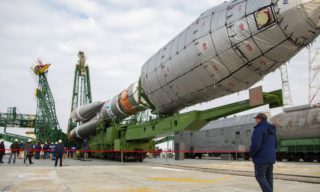The launch of Proton-M booster with DM-03 upper stage and Glonass-M space devices took place from 81 launching pad of Baikonur Spaceport on July 2, 2013 at 6 hours 38 minutes 21,585 seconds Moscow time.
The crash happened on ~32,682 second after the takeoff because of the yaw channel stabilization loss due to off-nominal operation of Proton-M booster control system angular-rate sensors. The structure broke and rocket parts fell beyond the launching pad. There we no heavy consequences such as victims or destructions. The task on setting Glonass-M space devices into the orbit wasn’t accomplished.
According to Ministry of Defense of Russian Federation and Roscosmos joint resolution dated July 2, 2013 Interdepartmental Board headed by Roscosmos Deputy Head A.P.Lopatin was formed to find out the causes of the crash and work out necessary recommendations.
The Board analyzed Proton-M booster design documentation, technical documentation and operational instructions, studied the process of Proton-M compounds construction, testing, transportation, storage and check, studied materials of the booster, analyzed telemetry and trajectory track data and carried out comprehensive analysis of booster crash considering all experiments conducted.
The board determined that during the launch “lift-off contact” signal issuing took place before actual takeoff and 0,4 second earlier than planned. The possible cause of early issuing could be early undocking of docking mechanism of launch pad power pneumatic connection from the booster. Considering the results of telemetry data analysis and booster flight simulation the Board determined that “lift-off contact” signal early issuing and transmission couldn’t be the cause of the crash.
The experiments on causation of angular-rate sensors off-nominal operation confirmed their possible misadjustment (180 degrees transition by installation of the devices) provided that electric connectors were installed properly.
Commission search for material facilities including Proton-M booster control system angular-rate sensors was organized at the site of the crash. The equipment was found, studied, packed, sealed and sent to booster manufacturing plant for further studies.
As a result of all researches the Board found force impact evidences on docking surfaces of 3 devices of 6. These evidences are similar to those appeared in the course of experiment on off-nominal installation. The layout of the imprints conforms to the layout on the device mock-up used during the experiment.
According to the results of the work accomplished the Board concluded as follows:
– The cause of the crash is misadjustment of angular-rate sensors of yaw channel in Khrunichev State Research and Production Space Center;
– Methods of control during ground preparation and testing in accordance with design and technical documentation and operational instructions do not enable to find out misadjustment of angular-rate sensors on the booster;
– The flow appeared during the flight and is of processing character;
– The Board continues its work to determine the causes on early undocking of docking mechanism of launch pad power pneumatic connection from the booster
Image credit – Roscosmos



















